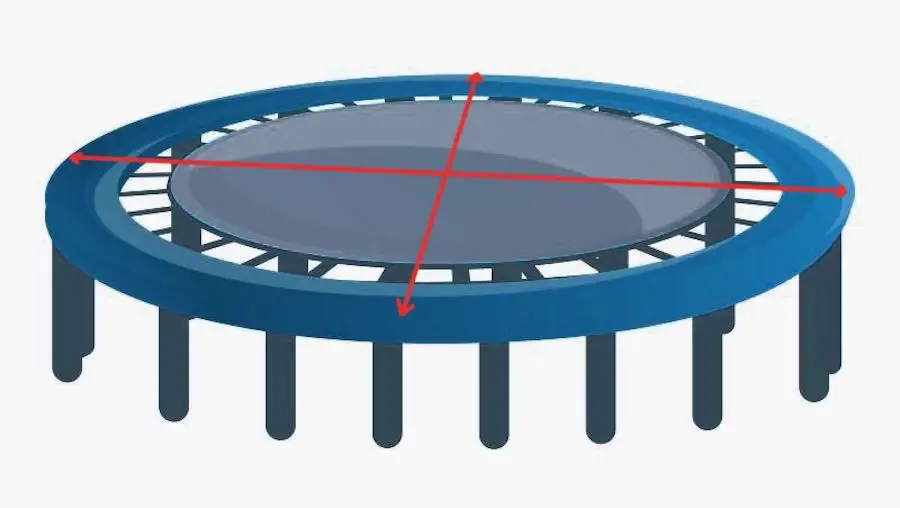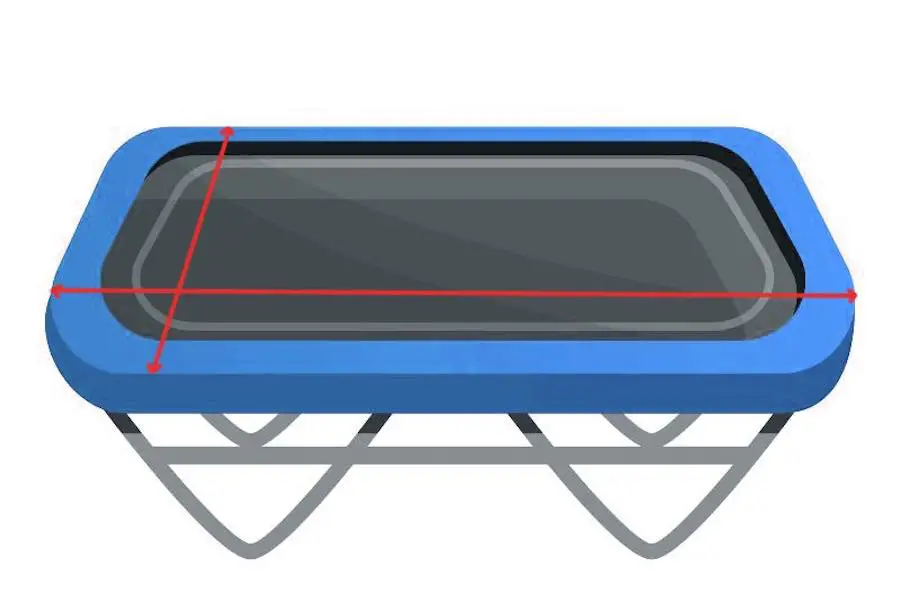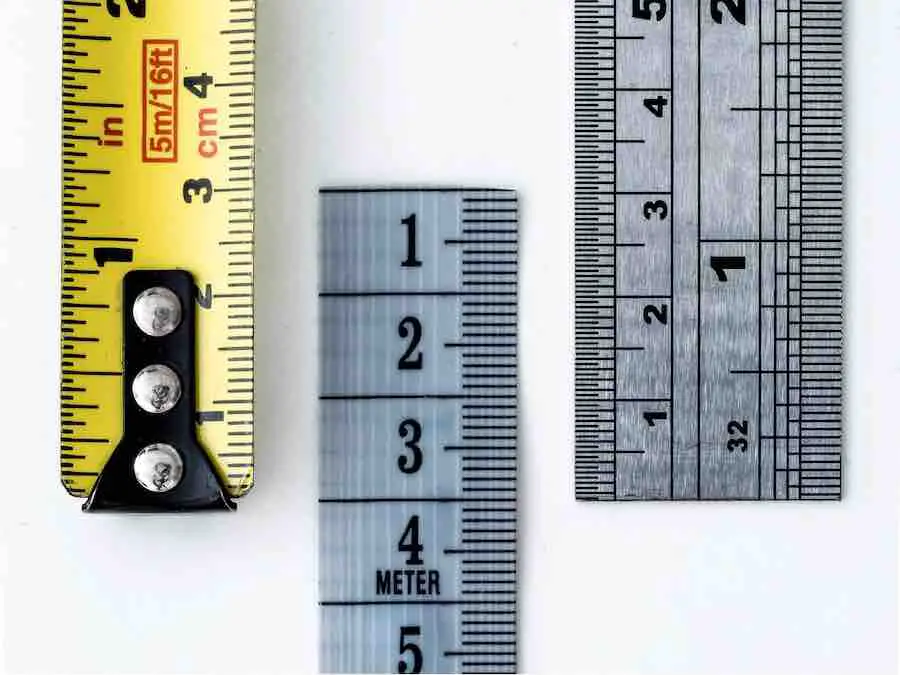
Let’s face it; trampolines are a ton of fun. But if you keep your trampoline outdoors, it’s only a matter of time before you will need to conduct preventative maintenance.
When the time comes, be proactive! Don’t wait until your leg goes right through the mat before replacing those worn-out trampoline parts.
Instead, learn how to measure your trampoline and choose fitting replacement parts before it’s too late.
Table of Contents
- How to Measure a Trampoline Mat (Jumping Surface)
- How Do You Measure a Trampoline to Replace Parts?
- Wrap-Up
How to Measure a Trampoline Mat (Jumping Surface)
The trampoline mat is the heart and soul of your trampoline. Without it, you would just have a weird, round frame in the backyard.
When Do You Need to Replace a Trampoline Mat?
Don’t compromise on safety – if you see tearing, fraying, stretching, or sagging, it’s time to replace your trampoline mat.
It’s a good idea to replace this jumping surface every two years, even if, at first glance, it seems to be in mint condition.
That’s especially true for outdoor trampolines. Most trampoline mats are made out of polyethylene or nylon, which can take quite a bit of brute force bouncing. But sooner or later, sunlight, the natural enemy of all polymers, takes its toll.
That’s right – UV light will make your trampoline mat brittle. The longer you wait to replace your trampoline jumping mat, the higher the chances of it tearing right as you land from a bounce. There are ways to slow down the UV degradation process, but no way to stop it (scientists, set your priorities straight!).
So, we established that getting a new mat every couple of years is ideal if you value safety. When the time comes to replace your mat, you have two choices:
- Go to the manufacturer’s website and try to track down the specifications
- Measure it yourself.
Here’s everything you need to know to calculate the size of your trampoline mat.
Facts to keep in mind:
- Measure the frame, not the mat. Jumping mats are smaller than the outside edge. For example, a 12 ft trampoline frame only has 10 ft of actual jumping space. However, companies list their trampoline mats by the frame diameter, not the actual size of the mat.
- If your trampoline mat has a tear or a hole, don’t try to measure it. Calculate the size using the frame outer edge and spring sizes instead.
- Count the V-rings. The V-rings are the hooks that connect the mat to the springs that tie it to the frame. You’ll need to get a model with the same amount of V-rings to match your trampoline’s outer edge. You can either count the V-rings on the mat or the spring holes on the frame.
Measuring Round Trampolines

- Measure the diameter: start at the outer edge of the round frame. Measure straight across to the other side, making sure your tape measure goes through the center point. If you imagine the trampoline as a clock, this would be the 12 to 6 o’clock position.
- Then, repeat step one, only measure the 3 to 9 o’clock position (perpendicular to the previous measurement).
- Take the average if the diameters aren’t precisely the same. The measurements should match or be very close to one another. You may get different results if the round trampoline frame is slightly bent or not standing on level ground.
- Count the number of springs that connect the jumping surface to the frame – this number must match to make the new jumping surface fit well.
Measuring Octagonal Trampolines
Getting the dimensions of your octagonal trampoline is very similar to measuring round models. Again, measure the diameter using two lines that intersect and form the right angle.
Since octagons have corners, make sure to measure from one octagonal corner to the opposite corner (as opposed to an octagonal side to the opposite side).
Don’t forget to take a spring count.
Measuring Rectangular Trampolines

Just like round models, rectangular trampolines come in many sizes. When measuring a rectangular trampoline, you need to get two dimensions – the length and the width.
Measure the size of the frame, just like with other types of trampolines.
When getting your measurements, make sure your measuring tape is perfectly parallel with the trampoline frame. If your measuring tape skews and doesn’t follow the frame’s direction, you might get the wrong measurement. That’s why I’d recommend measuring the border itself.
Remember to get an accurate spring count.
How Do You Measure a Trampoline to Replace Parts?
Most people need to replace the trampoline mat first, but sometimes other components need replacing too. Having serviceable components and the safety enclosure intact is just as vital for safety while bouncing.
When Do You Need to Replace the Safety Enclosure Net?
Most outdoor trampolines have a safety net installed upright around the entire jumping surface. Take the time to periodically inspect this critical trampoline part for the safety of the jumper.
Like jumping mats, in most cases, trampoline safety enclosure nets simply deteriorate in the sun over time. This process is called UV degradation, and it’s a common issue in plastic materials exposed to direct sunlight. Over time, the safety enclosure’s plastic mesh becomes weaker and more brittle, so it may tear when it’s most needed. The first sign of UV degradation is discoloration, but if your net is light-colored, it may be difficult to notice.
Consider replacing your trampoline safety net every two years to prevent potential accidents.
How to Measure a Trampoline Net
A picture is worth a thousand words, I hope the video was helpful. You need three data points to calculate your replacement safety net’s dimensions:
- The size of the trampoline frame
- The style of the safety enclosure poles
- The number of safety enclosure poles on your trampoline
The Size of the Trampoline Frame
I already explained how to measure your trampoline frame size depending on the shape of the unit. When it comes to determining the pole type, that’s not difficult either. In essence, only five different pole styles exist:
- Straight
- Straight curved
- Arched
- Curved
- Enclosure with top rings
The Style of Safety Enclosure Pole
Getting the right enclosure net depends on the type of pole because installation is slightly different for each. However, with a little adaptation, you’ll be able to install the safety net on any type of bar.
The Number of Enclosure Poles
It’s important to count the number of enclosure poles on your trampoline. Apart from getting a safety net that’s big enough for your trampoline, getting one with the right number and distribution of tying spots is paramount.
When Do You Need to Replace Trampoline Springs

Trampoline springs are typically made of stainless steel, so they don’t suffer corrosion damage or become weaker over time.
Even though springs don’t often break or corrode, they do overstretch.
While this is usually not a safety concern, overstretched springs will reduce the bounce you get from your trampoline. New springs are very flexible – they expand when you land on the jumping mat, sending you straight back up, sky-high. The tighter the springs, the higher the leap!
However, these steel coils naturally lose their flexibility over time and become somewhat loose, making the trampoline jumps less thrilling.
If you want to bring the bounce back to your old trampoline, try replacing the springs. You’ll need two pieces of info to replace your trampoline springs the right way:
- Spring size
- Spring count.
How to Measure Trampoline Springs
- Remove three springs (try to pick springs with the least amount of “stretch”)
- Take measurements of all three springs from hook end to hook end
The spring’s total length includes the hook on all listed trampoline part specs. You can assume that the spring with the shortest dimension is the most accurate representation for purchase replacement.
Count your springs so you can replace them all.
Typically, 12 and 14-foot models use 72 springs. Trampolines larger than that often use 96 springs or more.
Wrap-Up
Get the most out of your trampoline and keep your family safe by conducting preventative maintenance and changing worn-out parts. If you’re in the market for a new trampoline, be sure to check out our article on the best trampolines with a basketball hoop. If you have any questions or want to share your own experience, please leave a comment below!
Here at The Home Dweller, we are completely reader-supported. If this article was valuable to you, please help us out by sharing it on social media. Here’s to more hours of fun in the backyard!!

